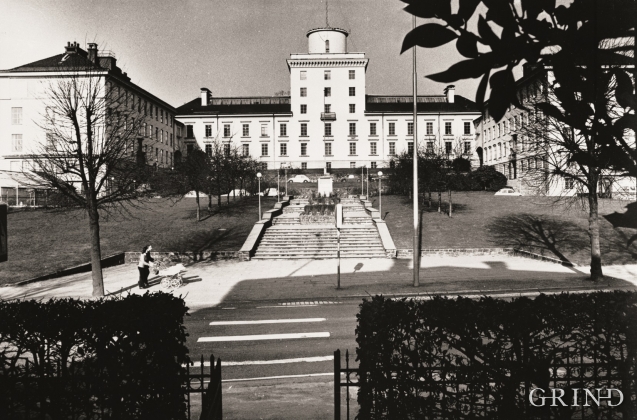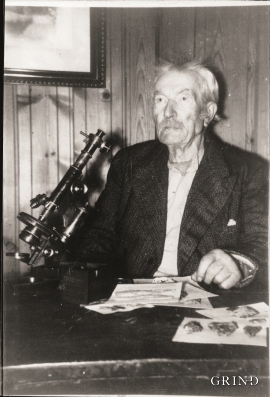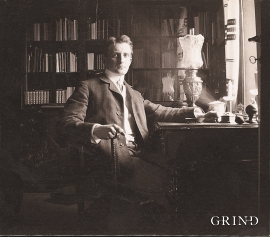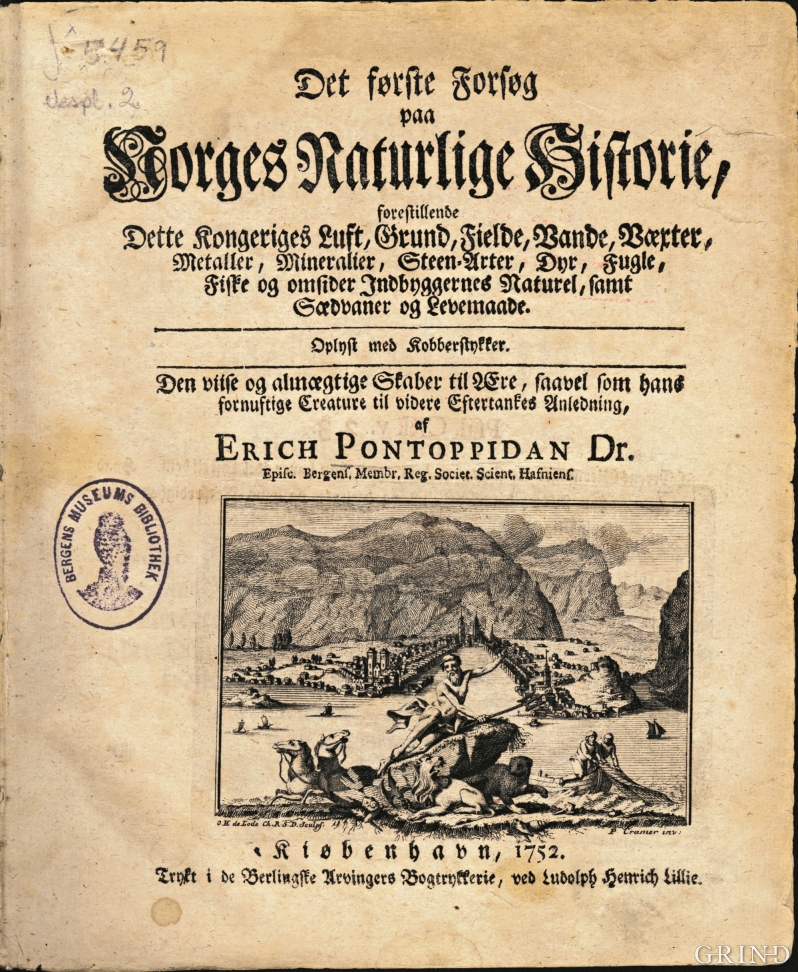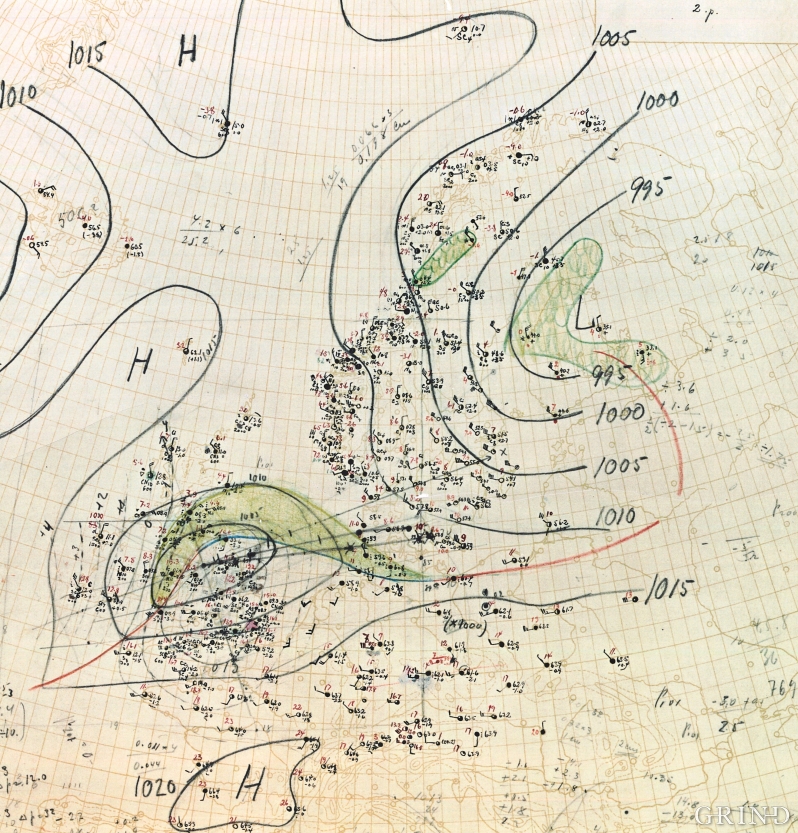Published: 23.05.2019 | Author: Knut Fægri , Hilde Sandvik, William Helland-Hansen, Bjarne Meidell, Dagfinn Moe
Geofysisk Institutt, en grunnstein i naturforskningens nyere historie i Bergen.
When Professor Emeritus Knut Fægri (1909-2001) was asked to write the book's chapter about the natural science pioneers of Hordaland, he answered unequivocally, "yes". It was one of the last things he wrote before he died, at the age of 92. In typical Fægri language he presents some of the scholars who, in the time before the University of Bergen was founded, led the way in studying the natural science of The West Country.
Knut Fægri himself was one of the main pioneers in natural history during the 1900s with his development and subsequent application of pollen analysis. He was also one of the most important teachers of natural history. Thus he belongs to a long tradition at the Bergen Museum, later University of Bergen. The popularist scientific journal Naturen was published from here since 1887, ten years after its inception in Kristiania (since renamed Oslo) by geologist Hans Reusch. Reusch, and since, Carl Fredrik and Niels Henrik, also geologists, made it an art form to communicate research results in a sharp and elegant fashion. It was always one of Knut Fægri's expressed ambitions to continue their work, and he was able to fulfill this vision as editor of the journal Naturen for 30 years.
Fægri only managed to deliver a draft of this chapter with comments in the text where he had intended to fill in more names. These are now filled in by the other editors who have also written the framed texts and figure captions.
The chapter was concluded by: Bjarne Meidell, Dagfinn Moe, Hilde Sandvik and William Helland-Hansen
Exploring the natural history of The West Country
As long as there was no seat of learning at university level in western Norway, the study of this remote part of the country was more or less coincidental. Local amateurs and public servants from other parts of the country gave occasional contributions, largely determined by their individual preferences and knowledge. Until the middle of the 1800s it was largely the priesthood, and eventually also those who studied medicine, who fostered the first natural historians.
There aren't many names to mention from either the period of Danish rule or from the Period when Norway was in a union with Sweden (1814-1905). Few people were aware of western Norway's splendid nature, and even fewer understood it. The Bishop in Bergen, Erik Pontoppidan (1698-1764), was actually Danish; he had a much broader background in natural history than modern day theologians. When he somewhat unwillingly took over his diocese in 1747, he became so overwhelmed by its nature that he spent much of his life writing Forsøg paa Norges naturlige Historie (1752-53) , (known in English as The Natural History of Norway), a two-volume book where he summarized what was known about Norway's natural history up until that time. Which wasn't much, but the book nonetheless became a milestone in the development of knowledge about the country, and not least, western Norway.
200 years of botanical research
When the German-born botanist Georg C. Oeder (1728-1791) conceived the idea of what we now know as Flora Danica (a comprehensive atlas containing pictures of all the wild plants native to Denmark), his plans were rather unrealistic, and Oeder himself soon disappeared from the picture. But the idea of the atlas endured, and when the Bergen-born botanist Martin Vahl (1749-1804) gained control of Flora Danica , Norway became well represented. The first volume included 60 species, 10 of which were common to both countries. The rest were entirely Norwegian. Here it should be admitted that most of these were alpine species, though the west coast was also represented. It was at least a beginning, and probably the one that gave the impetus to the next century's eager collecting activity and to the growing botanical understanding of the special nature of Western Norway. Norwegian botanists who travelled from eastern Norway, like father and son Mathias (1789-1862) and Axel Blytt (1843-1898), and Johannes Musée Norman (1823-1903), made important contributions.
During the 1800's there was a disproportionate contribution from non-Norwegians compared to local researchers, especially in botany. In fact, the latter category actually didn't exist. Jørgen Brunchorst (1862-1917) was the first local professional, but he became so involved with the Bergen Museum as such that he never played much of a role in the discovery of Norway's nature.
It wasn't until Jens Holmboe (1880-1943) started working at the Bergen Museum in 1906 that botany really became an established field in western Norway, and then especially in Hordaland. 19th Century botanists had understood that the flora of the west coast of Norway was unique, not least the many Swedish collectors who visited our plant localities in summer. Holmboe insisted that comprehensive local research was needed to provide a basis for investigative research. His successor, Rolf Nordhagen (1894-1979), further developed methods from the purely topographical documentation, to a comprehensive historical and plant-ecological approach.
In addition, research in plant physiology became established, represented by Oscar Hagem (1855-1982). He was also interested in the problems of plant distribution and occurrence in western Norway as compared with their occurrences elsewhere, and he drew practical conclusions from his studies that had consequences particularly for the planting of forests.
The pioneers of zoology
While botanists concentrated mainly on land - there were essentially no algal researchers at that time - the focus for zoologists was the sea. The founder of the Bergen Museum, Wilhelm Frimann Koren Christie (1778-1849), understood already how important it was to increase knowledge about life in the ocean. He collected his own specimens, as well as sent others out to be investigated. He also encouraged other travelling researchers to make a stop at Bergen. One of these was Baron M.W. von Düben, who wrote after his visit in 1843-44 that the zoological collections here exceeded any others of its kind that ever existed in Norway. Christie collaborated also with the parish Priest in Manger, Michael Sars (1805-1869). Fridtjof Nansen (1861-1930) came to the Bergen Museum as curator of zoology in 1882, but it turned out to be a short-lived career and of little significance for the study of Hordaland's fauna. On the other hand, he was an important driving force for the establishment of the Biological Station, which had its first premises at Marineholmen.
Marine biology remained the leading sub-discipline within zoology, especially with the later development during the Danish August Brinkmann's (1878-1940) leadership of the Museum's Zoological Department and the Marine Biological Station at Herdla. For the most part the field of zoology was stronger than the other sub-disciplines in Bergen during the 19th Century, since researchers like Johan Koren (1809-1885), Daniel C. Danielsen (1815-1894) and G.H. Armauer Hansen (1841-1912) made important contributions to our knowledge about western Norway's marine fauna. Another deserving mention is Herman Friele (1838-1921), a well established merchant and enthusiastic amateur zoologist, with a speciality in snails. He became a main supporter of Danielsen's efforts to develop the museum into a professional scientific institution. Vice curator Olaf Jensen (1847-1887) also earned his reputation from this period. Molluscs and leeches were his speciality, but it was more his reputation as the best museum curator that had ever been associated with the natural history collections that made him famous, Jensen's guide to the zoological exhibits was so good that it was also used after the exhibits were moved after renovations in 1898.
Alongside the purely scientific zoological community at the Bergen Museum, another community emerged around the turn of the century which was partially cooperative with, and partially in irreconcilable conflict with the zoologists. This was the fisheries biologists, with Johan Hjort (1869-1948) as its scientific front figure, and with Fridtjof Nansen as one of its most important supporters (loyalty was not one of Nansen's foremost characteristics. Although the fisheries research had no specific geographical boundaries, the scientists of the Fisheries Ministry played an important role in investigating this part of the country. Studies of the local fish populations and shellfish distributions etc. have been important also for understanding the general biological conditions. The at times bitter conflict between the Museum and the Ministry, which started with different views on choosing the location of fisheries studies (Christiania - now Oslo - or Bergen), prioritizing curatorial work or ocean research, focusing on zoology or botany, eventually evolved into a productive cooperation between the two groups.
Another Norwegian researcher that belongs to this period in Bergen zoological history, one of the big names in zoology but often forgotten here at home, is Leonhard Stejneger (1851-1943). He worked in our zoological community without tenure for some years, and in his time at Bergen wrote several original works including Bidrag til Vestlandets ornithologiske fauna (in English: "The Bird Life of Western Norway"). He later emmigrated to the USA and ended up as the director of the Smithsonian Institution.
Bergen – cradle of modern meteorology
The period around 1900 was a time of important growth for the scientific community in Bergen. During the course of a few years several new scientific communities grew up that were to make significant marks in research within their time. Norway's Fisheries Ministry led by Hjort was a main part of this, but eventually a geophysical institute emerged in Bergen. One of its most enthusiastic driving forces and its first director was Bjørn Helland-Hansen (1877-1957). He did ground-breaking work in physical oceanography using methods to calculate oceanic current patterns.
Vilhelm Frimann Koren Bjerknes (1862-1951) joined the Geophysical Institute the same year it was founded, in 1917. Here he developed the Bergen School of Meteorology, which eventually became world famous. One of the most important premises for good fisheries is to be able to predict the weather as accurately as possible. Everyone with any connection to Western Norway knows just how unpredictable the weather can be. For Bjerknes and his students, it was the practical and theoretical aspects of weather prediction that were the focus of their research. It was also Bjerknes who established 'Værvarslinga på Vestlandet', regular weather reporting for Western Norway.
Geology - young science in the western mountains
Bedrock geology got off to a late start in Western Norway, even though Hans Reusch (1852-1922), who was the director of the Norwegian Geological Survey, wrote a few very important works from his native region of Bergen. He showed among other things fossils from strongly metamorphosed bedrock, and demonstrated that the fossils were younger than the bedrock. As a new phenomenon this drew great attention at the time. He took his ideas from the Bergen area with him to the Hardanger plateau where his mapping contributed to the thrust-sheet theory being accepted.
With this notable exception, few Norwegian bedrock geologists up until the early 1900s had any knowledge about the intricate geology of western Norway. The more advanced methods required to investigate this had not yet been developed. A fairly small amateur geology collection existed at the Bergen Museum long ago, but it wasn't until Carl Fredrik Kolderup (1869-1942) gradually became more strongly associated with the museum, becoming its director from 1914 to 1939, that an understanding of western Norway's complex bedrock geology began to emerge. C.F. Kolderup and his son Niels-Henrik (1898—1971) and their many students and collaborators gradually mapped the bedrock of western Norway, and this work was supplemented by a number of dissertations of a more general nature by the mineralogy department.
Other aspects of Reusch's work - including mapping of potholes and studies of land forms, not least the strandflat - became important for research with the newer scientific field of Quaternary geology. Amund Helland, also from Bergen (1846-1918), Professor of geology at Det Kongelige Frederiks Universitet i Kristiania (later called the University of Oslo), was also a pioneer with his articles on mineral deposits and mining activity, as well as on the creation of fjords and cirques. But he is best known for his major 39 volume work Norges land og folk (in English: "Norway's landscape and people "). Even though Nansen didn't make much of a name for himself in zoology, his later work documenting the strandflat in Hordaland became a reference work in Quaternary Geology. Less known are the publications of the state geologist of the Norwegian Geological Survey Johan Rekstad (1852-1934). His observations of glaciers early in the 1900s, from among other places Folgefonna, are important for reconstructions of glacial movement in more recent times. Rekstad was an accomplished photographer and was one of the first geologists who used a camera actively in his scientific documentation.
Foundation of the University
The rise of the scientific community and the study of western Norway's natural environment since the founding of the Bergen Museum in 1825 had been somewhat haphazard, determined by the roads that were open at any one time, and apparently led by chance. However, within its limitations, it was powerful and effective, and it formed a solid foundation for the more extensive undertakings of the new era at the transition to the University of Bergen.
Niels Hertzberg (1759–1841)
Son of the well known "potato priest" Peder Harboe, Niels Hertzberg grew up at Finnås in Bømlo in an environment with strong interests also outside of theology. Following his wish to be a surveyor he left to begin his studies in Copenhagen, but was persuaded instead to study theology. A long service to the priesthood in Hardanger was combined with an impressive spectre of wordly activities. He practiced as "medicus" and in 1802 carried out Dr. Jenner's vaccination program against smallpox throughout most of Hordaland. He also carried out studies in astronomy, physics and meteorology, created an electricity machine and a planetarium, was a gardener, surveyor and a land court adjudicator in the municipality. He was also politically active and was voted into Parliament in 1814. He is perhaps nonetheless best known for his meteorological journals which contain the oldest observations of temperature and air pressure in Norway (p. 500). He made his instruments himself, both his barometer and thermometer. His instruments were so good that he was asked to make some for others, including astronomer Bohr in Bergen and professor Hansteen in Christiania.
Wilhelm Frimann Koren Christie (1778–1849)
Wilhelm Frimann Koren Christie (1778-1849) was not only the founder of the Bergen Museum, and thereby of the first scientific institution in Bergen; he carried the entire development of the museum on his shoulders right up until his death in 1849. For a number of years he represented scientific development on the museum's board. He prepared, wrote and archived the minutes for the meetings. He was most interested in the marine fauna, not surprisingly, since this was readily accessible from Bergen. On this basis he sent out for example short circulars with guidelines as to how to collect "Natural objects caught in the sea" in 1839. This is supposed to have been very helpful for building up the collections.
Michael Sars (1805–1869)
It sometimes happened that Michael Sars forgot to attend Sunday church services in his eagerness to collect odd creatures from the sea floor. He completed an education in theology because he had to earn a living, it says in the biographies, but it was zoology and above all palaeontology that Michael Sars really pursued, first at high school in Bergen and then later during his time as a student in Christiania. When he eventually earned his living as a priest, first at Kinn in Florø and in 1839 at Manger, he was able to pursue marine zoology alongside of his parish duties. He gained an international reputation when his book was published in 1835. It had the comprehensive title, " Beskrivelser og iagttagelser over nogle mærkelige eller nye i havet ved den bergenske kyst levende dyr ", which in English means, "Descriptions and observations of things strange and new living in the sea by Bergen's coast".
His descriptions of the transformation from fertilized egg to larvae to adult for jellyfish, molluscs and echinoderms was ground-breaking work. In 1854 he was appointed, by a special decision of the Parliament, as an Honorary Professor of Zoology in Christiania.
Daniel Cornelius Danielsen (1815–1894)
Danielsen is best known for his medical studies and for laying the Foundation for Armauer Hansen’s later breakthrough in mapping the leprosy bacterium. His enthusiastic interest in animal life in the oceans is less recognized, but it had major consequences for the development of the natural sciences in Bergen. As chairman, and later serving on the board of the Bergen Museum's natural history department, he brought to fruition Christie's visions. It was also Danielsen who introduced modern marine research when he organized and led the great Norwegian North Sea expedition in the late 1870s. He published many scientific articles on the marine life of western Norway, together with Johan Koren (1809-1885), the museum's first curator.
Hans Reusch (1852–1922)
Hans Reusch was supposedly on his way home from fieldwork one rather grey day in western Norway. He stood and poked at some stones with his umbrella near Ulven at Os when he happened to turn over a fossil. This according to the story formed the basis for his publication Silurfossiler og pressede Konglomerater i Bergensskifrene (Silurian Fossils and Metamorphosed Conglomerates in Bergen Shales", from 1882. This was translated into German the following year and earned Reusch a name among geologists. But he wasn't just an academician, even though he was director of the Norwegian Geological Survey for nearly a half of a century. Among other things he was interested in art. Reusch founded and then was editor of the journal Naturen during the time before photography had taken over as an important aid for geologists. Instead he drew what he saw: potholes, strandflats, meteorites, glaciers' advance and retreat. Also The Natural History Road Guide includes many of Reuch's talented creations. Although he was also honoured for his scientific work - he was among other things awarded an honorary doctorate from Oxford University - he will be most remembered as a great public educator.
Johan J. Havaas (1864–1956)
”Havaas was unique. His career will never be matched", wrote Knut Fægri in his obituary for the hobby botanist. It is said that Johan Havaas had to choose between books and tobacco as a young man. He did not have the money for both. The boy from a mountain farm in Granvin had as his goal to build up a small academic library. Every Sunday he went for nature walks with his friend Sjur Selland and tried to identify all of the plants and flowers.
Havaas never lost his passionate interest for all that grows in nature. He eventually became one of the most important sources of botanical knowledge at the Bergen Museum. It is stated in the museum annals that between 1895 and 1954 he supplied the museum with 3,962 specimens of mosses and 7,900 of lichen, in addition to fungi and vascular plants. Most impressive of all were the dried plant collections he built up, botanical type specimens for scientific use, which he published in more or less identical sets of pressed herbarium plants.
Why did Havaas choose to make his hobby into his life's work? Once he was asked what it was that excited him most from his long research career. "How wonderful the space is utilized out there - in nature, and how fascinating the interrelationships are: How the one intimately affects the other", was the answer.
Plant collectors
The collection and documentation of plants since the end of the 1800s was done by a few competent individuals, several of whom did not have a formal botanical or academic education, and often with the support of the Bergen Museum. In the museum director Brunchorts' period alone, the collections increased by more than 40 000 specimens. This was largely due to the efforts of sixth form teacher at the Bergen Katedralskole Eugen H. Jørgensen (1862-1938), head teacher Jens Sjur Knutsen Selland (1867-1920) and small holder Johan J. Havaas (1864-1956), the last two from Granvin. Later, contributions were also made by small holder Torkel K. Lillefosse (1868-1946) in Strandebarm, and college teacher Jakob Naustdal (1895-1975) in Fana and head of the tax office Idar Langedal (1905-1992) in Modalen. Several of these made contributions of between 20,000 and 50,000 plants each. They wrote their own documentation or contributed to printed material on the flora of Hordaland.
Bjørn Helland-Hansen (1877– 1957)
"Whoever has seen him draw the most perfect figures on the charts, or handle instruments at sea, or after passing 60 years of age climbed the rope ladder on the ship “Altair” in bad weather on the North Atlantic,[...] - must be impressed by how the will makes one able to do extraordinary things even without fingers, "wrote the oceanographer Håkon Mosby in the eulogy for Helland-Hansen. When a winter storm destroyed many of his fingers during a northern lights expedition to the mountain Beskades in Finnmark, he continued to use his hands as an artist. The professor possessed the will to fulfill his goals, and there is still concrete evidence of this in the city's scientific community. Among other things he was a main impetus for the establishment of a Geophysics Institute, founded in 1917. As director of the board he also led the Christian Michelsens Institute from its inception in 1930 until he left in 1955.
Miranda Bødtker (1896–1996)
Miranda Bødtker was known as "a bohemian in Bergen". Maybe she wasn't quite one of the pioneers who discovered Hordaland's nature. But no one can dispute that she deserves a place among them. Bødtker was a legendary illustrator at the Bergen Museum, later University of Bergen. Over the course of 70 years she helped innumerable botanists to illustrate their work, portraying so precisely yet nonetheless so beautifully that it is hard to imagine even today. Miranda Bødtker was very self-critical and often wrote "failed" on the edge of her illustrations, and she had a stamina that bordered on the pedantic. When Rolf Nordhagen asked her to illustrate Norsk flora (Norwegian flora) for him, she first thought that there would be room for both colour and black and white. It wasn't until after she was well into the work that she realized that it was only going to be published in black and white. She continued nonetheless and produced a set in black and white, and a set in colour. She called them her own "Norsk flora - in watercolour" (Norwegian Flora - in Watercolour". These 1400 watercolours are today under the management of the Bergen Museum. Looking back over Bødtker’s work gives one an impression of the flora that is all around us in western Norway.
- Brunchorst, J. 1900. Bergens Museum 1825–1900.En historisk fremstilling. Bergens Museum.
- Universitetet i Bergens historie. I–II. 1996. UiB. Universitetsforlaget.

